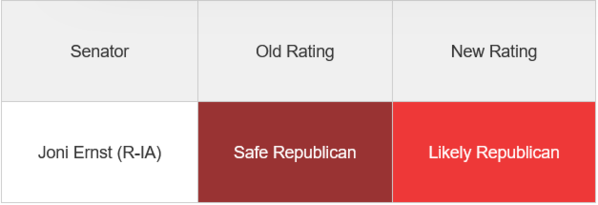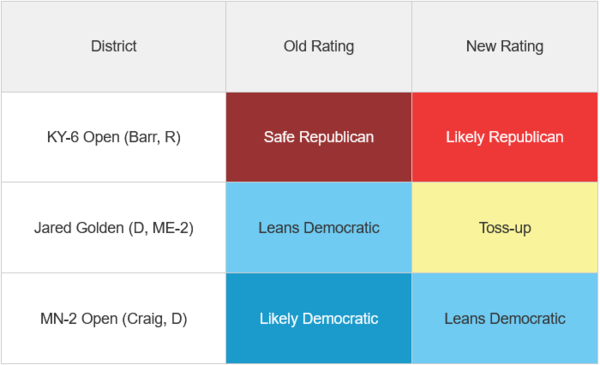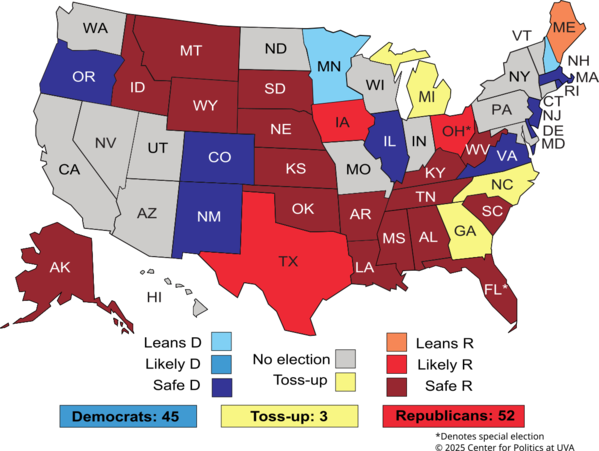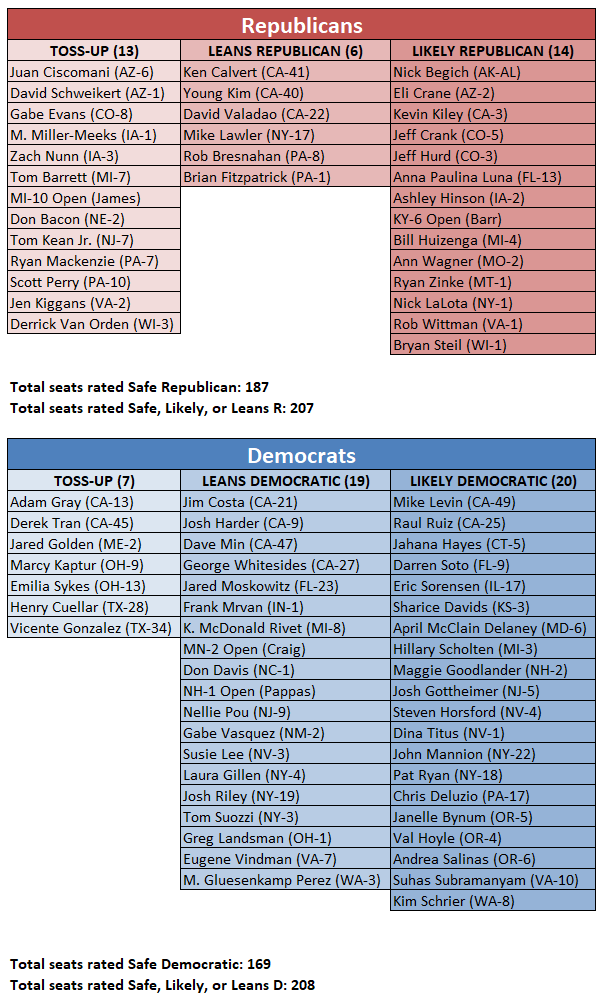Rating Changes: Iowa Senate, ME-2, and More
A Commentary By J. Miles Coleman and Kyle Kondik
KEY POINTS FROM THIS ARTICLE
— We are making four rating changes this week—one in the Senate and three in the House—with two races getting better for Democrats and two getting better for Republicans.
— The Iowa Senate race moves onto the periphery of the competitive board this week. Sen. Joni Ernst (R-IA) was in the news recently for comments on health care, although the bigger reason for the switch is that she drew a potentially credible Democratic challenger.
— The most notable House change is moving ME-2, the most Republican district held by a Democrat, to Toss-up, and we are also making a couple of other changes to open seats where talented incumbent House members are running for the Senate.
Table 1: Crystal Ball Senate rating change
Table 2: Crystal Ball House rating changes
Map 1: Crystal Ball Senate ratings
Table 3: Crystal Ball House ratings
Iowa Senate to Likely Republican
Over this last weekend, for those of us who try to keep up with political news, it was hard to miss a headline from an Iowa town hall. When defending the Medicaid cuts that the popularly known “Big Beautiful Bill” contained, Sen. Joni Ernst (R-IA) scoffed, seemingly in frustration, “Well, we’re all going to die.” Democrats, trying to make political hay out of the comment, replayed it frequently, and the quote quickly made its way into meme form. Shortly after the original town hall, Ernst posted a video to social media where she, citing her faith, sarcastically doubled down on her remark.
Though this was not the most artful example of politicking that we’ve ever seen, Ernst’s comments alone also did not really tempt us to immediately move off our Safe Republican rating for her race. It is the kind of thing that seems sure to end up in attack ads, but to what effect, we would not presume to confidently know. Donald Trump carried Iowa by 13 points last year and, despite being a top Democratic target when she was last up for reelection in 2020, Ernst won by a clear 52%-45%. Still, as Democratic strategist Adam Jentleson pointed out, by spiking the football in the second video, Ernst seemed to be daring Democrats to make an effort in Iowa.
Before last Friday’s town hall, Ernst already had a Democratic challenger in Marine Corps veteran Nathan Sage. A first-time candidate, Sage has stressed his working-class roots and background as a mechanic—a template used, with some success, next door in Nebraska by independent Dan Osborn, who lost by a respectable margin last year and seems likely to run again.
However, earlier this week, Democrats got a more proven recruit in state Rep. J.D. Scholten. With a career as a baseball player, Scholten is probably most known for his 2018 run for House: in Iowa’s very conservative 4th District, he came within about 3 points of ousting now-former Rep. Steve King (R), a far-right provocateur who seemed to have some white nationalist sympathies. Scholten tried again in 2020, although King lost his primary to a more mainstream Republican in now-Rep. Randy Feenstra (who is now running in the open gubernatorial race). While Scholten lost that general election by a much larger 24 points, he still did a little better than Joe Biden in the district. In 2022, Scholten ran for the legislature and was unopposed for a district covering Sioux City—last year, he had a competitive race and won reelection by 7 points as his district backed Trump 51%-48%.
Aside from having a credible opponent, Ernst could face a more challenging environment than she faced in either of her previous two elections. In 2014, she won as part of a broader GOP wave—and she got help from a gaffe-prone opponent. Six years later, she won reelection as Trump was carrying Iowa by a strong margin (Ernst ran a little bit behind Trump). It’s possible that 2026 could be like 2018: Iowa did not have a Senate election that year, but Democrats did end up winning three of the state’s four U.S House seats that year, and we suspect that if Iowa had had a Senate election, it likely at least would have been close.
So, with that in mind, we’re moving Iowa’s Senate race from Safe Republican to Likely Republican. This puts the Senate race in the same category as the state’s open-seat gubernatorial race, where Democrats recently got their strongest possible recruit, state Auditor Rob Sand.
House rating changes
Since we released our initial House ratings back in April, there have been a number of developments in Maine’s 2nd District, a 53.5%-44.5% Trump district. This district, which covers the vast expanse of what we would describe as the “non-touristy” part of the state, is held by Rep. Jared Golden (D), who has held the district since the 2018 Democratic wave. By presidential partisanship, it is the most Republican district held by a Democrat. Golden has carved out an independent image by sometimes backing Republican ideas, such as offering support for Trump’s tariffs and voting with House Republicans on the SAVE Act, a bill that would make proving citizenship a requirement for registering to vote and that Democrats dislike because of what they argue is the potential for it to make it harder for certain people, like married women who have changed their last names, to register to vote. Republicans dismiss such concerns and, regardless, the bill seems likely to die in the Senate because of Republican inability to overcome the filibuster. Golden creating distance between himself and the national party is a necessity in a district that voted for Trump all three times he was on the ballot. Golden barely hung on in 2024, beating now-former NASCAR driver and state Rep. Austin Theriault (R) by less than a percentage point.
In early May, former Gov. Paul LePage (R-ME) announced that he would run in ME-2. Later in the month, Theriault said he would not run this cycle and endorsed LePage. While it is still early in the cycle, LePage appears to be on a glide path to being the Republican nominee.
A couple of weeks ago, Golden said he would run for reelection to the House—he could have run for the state’s open governorship or even against Sen. Susan Collins (R-ME), although the latter never seemed like a real possibility (he once worked for her). One of the challenges for Golden if he ran statewide is that the same maverick-y votes and stances that make him viable in a right-leaning district’s general elections could hurt him in a statewide primary, especially because the state’s much more liberal 1st District has not had the same exposure to him, and its electorate would likely set the tone for a statewide primary. Put differently, Democrats who may be willing to give Golden a pass on some issues in his Trumpy district would probably see things differently in the context of a statewide primary.
Speaking of primaries, Golden may have one of his own, as state Auditor Matt Dunlap is reportedly taking a look at challenging Golden. Dunlap, who previously served as Maine’s secretary of state and as a member of the state legislature, was appointed by the Democratic-controlled legislature to his current job (auditor and secretary of state are appointed by the legislature and are thus unelected positions in Maine). Dunlap ran for the Democratic U.S. Senate nomination in 2012 and lost in the primary in a race ultimately won by Sen. Angus King, the nominal independent who caucuses with Democrats. Golden holds his seat in large part because of his deviations from party orthodoxy—so if Democrats nominated a more “generic” candidate, it would both complicate their efforts to hold the seat and signal that they’re comfortable with a “smaller tent” party.
LePage is challenging to assess. Now in his mid 70s, the controversial LePage was in some ways a proto-Trump, with a salty, combative disposition that proved appealing to at least some traditionally Democratic working class white voters, who predominate in ME-2—as part of his 2014 reelection result, he took 52.5% in ME-2, which foreshadowed the district’s pivot to Trump in 2016. In his two gubernatorial victories, LePage never won a majority of the statewide vote, edging out an independent in 2010 with just 38% and then boosting his vote share to 48% in 2014, fending off a challenger from the then-occupant of ME-2, Mike Michaud (D), by about 5 points in the gubernatorial race. Republican Bruce Poliquin flipped ME-2 from blue to red in the same election, later losing to Golden in 2018.
LePage tried to reclaim his old job in 2022, but he was soundly beaten by incumbent Gov. Janet Mills (D) statewide. Still, LePage carried ME-2 by about 2.5 points against Mills. It may be that LePage is yesterday’s news at this point and that the gubernatorial race doesn’t provide a good template for the House race because LePage’s opponent is set to be Golden as opposed to Mills. LePage also has very publicly lived off and on in Florida for several years, although he is registered to vote at an address in Augusta (Golden has already poked at LePage’s residency). It also stands to reason that if Golden could survive 2024, he should also be able to survive 2026.
On the other hand it may be that LePage is actually a strong opponent who can overcome the typical challenge of defeating a non-presidential party incumbent in a midterm year, particularly in a district that is clearly Republican-leaning these days. If it’s the case that Republican candidates need to be more Trumpy to get irregular Trump voters off the couch in the midterm—which is something that many Republicans seem to believe even as that sort of strategy could backfire if Trump is broadly unpopular next year—LePage seems to be a decent fit for such a strategy.
Long story short, we were very close to starting ME-2 as a Toss-up in our initial rankings, and given how the race has developed so far, we now think that’s where it belongs. So ME-2 goes from Leans Democratic to Toss-up.
We are also making a bipartisan pair of rating changes in districts where some especially strong incumbents have opted to run for Senate. In Kentucky and Minnesota, respectively, Reps. Andy Barr (R, KY-6) and Angie Craig (D, MN-2) were reelected last year by margins that were roughly double what their presidential counterparts achieved in their districts. We are moving both open districts to more competitive categories, although we still favor the incumbent parties in each.
Aside from the deep blue KY-3, which is basically coterminous with Louisville’s Jefferson County, KY-6 is the least Republican of Kentucky’s six districts. Fayette County, which includes Lexington and is the state’s second most populous county, casts about 40% of KY-6’s vote, although it is usually overwhelmed by the surrounding counties, which are much redder. Perhaps the most significant change Kentucky saw during redistricting had to do with the placement of Franklin County, which contains the state capital of Frankfort. Since Henry Clay’s time in office, Fayette and Franklin counties shared a district—in the 21st century, that configuration kept the district in Democratic hands in 2010, and helped Democrats give Barr a serious challenge in 2018. But for 2022, KY-6 shed Franklin County and picked up some rural counties, which moved the district a few points to the right.
Republicans—not without good reason—have downplayed recent Democratic statements suggesting that this Trump +15 district could be flippable. This district is several points redder at the presidential level than the aforementioned Golden’s seat is, although Democrats were able to pick off a few comparably red seats under the optimal political circumstances of 2018. Democrats have produced a credible recruit in former state Rep. Cherlynn Stevenson. Stevenson held a Lexington-area legislative seat for three terms before being narrowly ousted last year. Other Democrats, such as Lt. Gov. Jacqueline Coleman and former state legislator and gubernatorial candidate Rocky Adkins, have also been mentioned as potential candidates. On the Republican side, state Rep. Ryan Dotson is the only announced candidate, although Republicans have a deeper bench than Democrats do, so other GOP entrants seem almost inevitable. We are pushing this district to the very edge of the playing field by moving it from Safe Republican to Likely Republican.
In Minnesota, Craig’s MN-2 is the Minnesota district that most matches the state’s partisanship—that is to say, Kamala Harris carried it by mid-single-digits. The Democratic primary to replace Craig is, as of this writing, basically a two-way race that we’d rate as at least “Likely Matt.” Although there are a few other candidates in the race, it has shaped up as a race between former state Sen. Matt Little (D) and state Sen. Matt Klein (D).
Both Little and Klein have histories in Dakota County, the district’s population center, although their electoral careers have seen different trajectories. In 2012, Little, who was still in his twenties, was elected mayor of Lakeville, the county’s largest municipality. In 2016, Little flipped a state Senate seat by running almost 20 points ahead of Hillary Clinton—four years later, he lost his seat 55%-45% and ran a little behind Joe Biden. Klein was also originally elected to the state Senate in 2016—he has had less eventful races in a safe seat.
National Republicans, meanwhile, got a legitimate recruit last month with former candidate Tyler Kistner. A Marine Corps veteran, Kistner lost to Craig by about 2% in 2020 and 5% in 2022—he took 46% of the vote both times, with much of the margin change coming from a smaller third party vote in 2022. Though Kistner may not get a clear primary field, no other Republicans have entered the race. The ideal scenario for Kistner, or whoever the eventual Republican nominee might be, would probably involve Craig not being the Democratic nominee for Senate.
As an open seat with a competitive Democratic primary, MN-2 seems like a more attractive target for Republicans now than if Craig, a stellar fundraiser, had run for reelection. With that, we are moving it down from Likely Democratic to Leans Democratic, putting it in the same category as the state’s Senate race.
Today’s changes leave our House ratings as follows: 208 districts are rated Safe, Likely, or Leans Democratic, and 207 are rated Safe, Likely, or Leans Republican. There are 20 Toss-ups.
J. Miles Coleman is an elections analyst for Decision Desk HQ and a political cartographer. Follow him on Twitter @jmilescoleman.
Kyle Kondik is a Political Analyst at the Center for Politics at the University of Virginia and the Managing Editor of Sabato's Crystal Ball.
See Other Political Commentary by J. Miles Coleman.
See Other Political Commentary by Kyle Kondik.
See Other Political Commentary.
Views expressed in this column are those of the author, not those of Rasmussen Reports. Comments about this content should be directed to the author or syndicate.
Rasmussen Reports is a media company specializing in the collection, publication and distribution of public opinion information.
We conduct public opinion polls on a variety of topics to inform our audience on events in the news and other topics of interest. To ensure editorial control and independence, we pay for the polls ourselves and generate revenue through the sale of subscriptions, sponsorships, and advertising. Nightly polling on politics, business and lifestyle topics provides the content to update the Rasmussen Reports web site many times each day. If it's in the news, it's in our polls. Additionally, the data drives a daily update newsletter and various media outlets across the country.
Some information, including the Rasmussen Reports daily Presidential Tracking Poll and commentaries are available for free to the general public. Subscriptions are available for $4.95 a month or 34.95 a year that provide subscribers with exclusive access to more than 20 stories per week on upcoming elections, consumer confidence, and issues that affect us all. For those who are really into the numbers, Platinum Members can review demographic crosstabs and a full history of our data.
To learn more about our methodology, click here.




